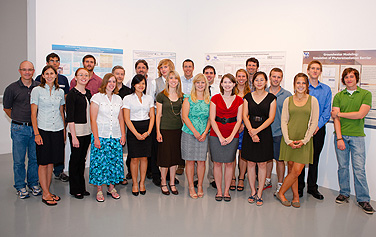News
Students present water quality findings

Students with their advisers at conclusion of National Science Foundation program devoted to environmental research. Photo: DOUGLAS LEVERE
-
 Print
Print -
 Comments
Comments
-
“Our experience with our ERIE doctoral program is that students find it easier to embrace interdisciplinary scholarship if they are exposed to an interdisciplinary research culture early in their career.”
A dozen undergraduates from around the country convened at the Center for the Arts on July 20 to discuss the results of studies they conducted during a highly selective, nine-week summer research program focusing on ecosystem restoration of area waterways.
In formal, morning presentations, the students, dressed well for the occasion, described their findings to peers and faculty advisers. Later, over plates of hors d'oeuvres, the young researchers chatted more about their work, referring to informational posters they created to support explanations.
The program, which received 220 applications for 12 spots, was run by Ecosystem Restoration through Interdisciplinary Exchange (ERIE), a collection of academic programs and research projects at UB that advance the science, engineering and policy of ecosystem restoration, with an emphasis on the Great Lakes and Western New York.
Like an NSF-funded doctoral program ERIE runs, the summer research program for undergraduates is unique in part because it has an interdisciplinary focus. This year's program brought investigators including engineers, geologists and biologists together to tackle problems in teams.
“Our experience with our ERIE doctoral program is that students find it easier to embrace interdisciplinary scholarship if they are exposed to an interdisciplinary research culture early in their career,” says Alan Rabideau, professor of civil, structural and environmental engineering and principal investigator of ERIE.
“Undergraduate research programs, in particular, are often transformative experiences for student scholars. And from the faculty perspective, we are amazed at what highly motivated students can accomplish in such a short time period.”
The summer research activities, funded largely by a $300,000 grant from the National Science Foundation's Research Experiences for Undergraduates (REU) program, included hands-on field and laboratory research; workshops discussing environmental and professional ethics, research methods and applied statistical methods; field trips to regional sites to learn about past, current and future ecosystem restoration efforts in Western New York; and more.
“I applied to get real experience in undergraduate research,” says Kaitlin Thomas, a participant going into her senior year at California University of Pennsylvania. “We worked a lot in the field, and I learned a lot of methods I didn’t know before. I got the experience of making a research poster.”
“I definitely enjoyed the opportunity to just get involved in research in the first place—the process of collecting, analyzing and presenting data,” says Elizabeth Hennessy, a UB student entering her junior year.
Hennessy, working under adviser David Blersch, studied the effectiveness of using a technology called an algal turf scrubber to remove excess phosphorus from water in the Black Rock Canal. The scrubber, employed successfully elsewhere in the United States, “cleans” dirty water by drawing it into a container holding algae that then consume unwanted contaminants. The treated water is then released back into the waterway from which it came.
Hennessy, who has worked with Blersch since fall 2010, says that while the team needs to gather more data to draw firmer conclusions, initial results show that the scrubber has been helpful in removing phosphorus. Further questions to consider include whether large quantities of sediment that the researchers discovered in the canal also contain phosphorus.
Other ERIE-REU program participants studied the following topics:
Identification of Groundwater-Stream Interactions with Implications for Biogeochemical Hotspots in Elton Creek, Western New York (Thomas’s project)
Evaluation of Dispersant Effectiveness for Oil Spills
Flow Visualization Study: Understanding Water Circulation in Lake Ontario through Physical Modeling
A Model of Hydraulic Conditions and Sediment Transport in Elton Creek, N.Y.
Spatial Dynamics of Nitrate in Conewango Creek, N.Y.
Laboratory and Numerical Simulation of Vertical Ground Water
Macroinvertebrate Collection as a Biotic Index for Elton Creek, N. Y.
Comparison of Methods Determining Nitrate Concentration in Stream Water
Groundwater Modeling: Simulation of Machias N.Y.
Phytoremediation System Using Two Modeling Approaches
Primary Production and Community Respiration in Different Cross-Sections of Elton Creek

Reader Comments